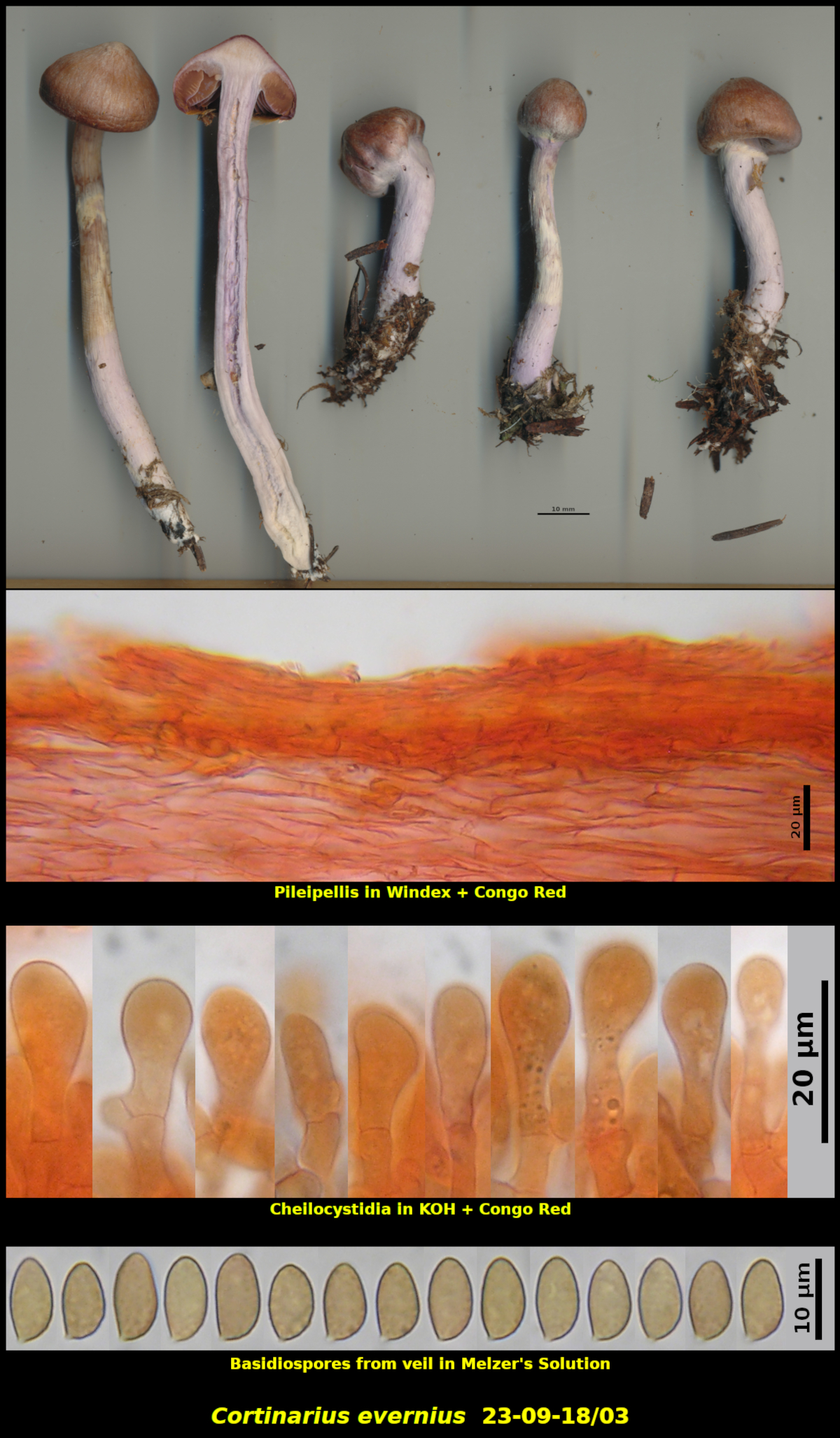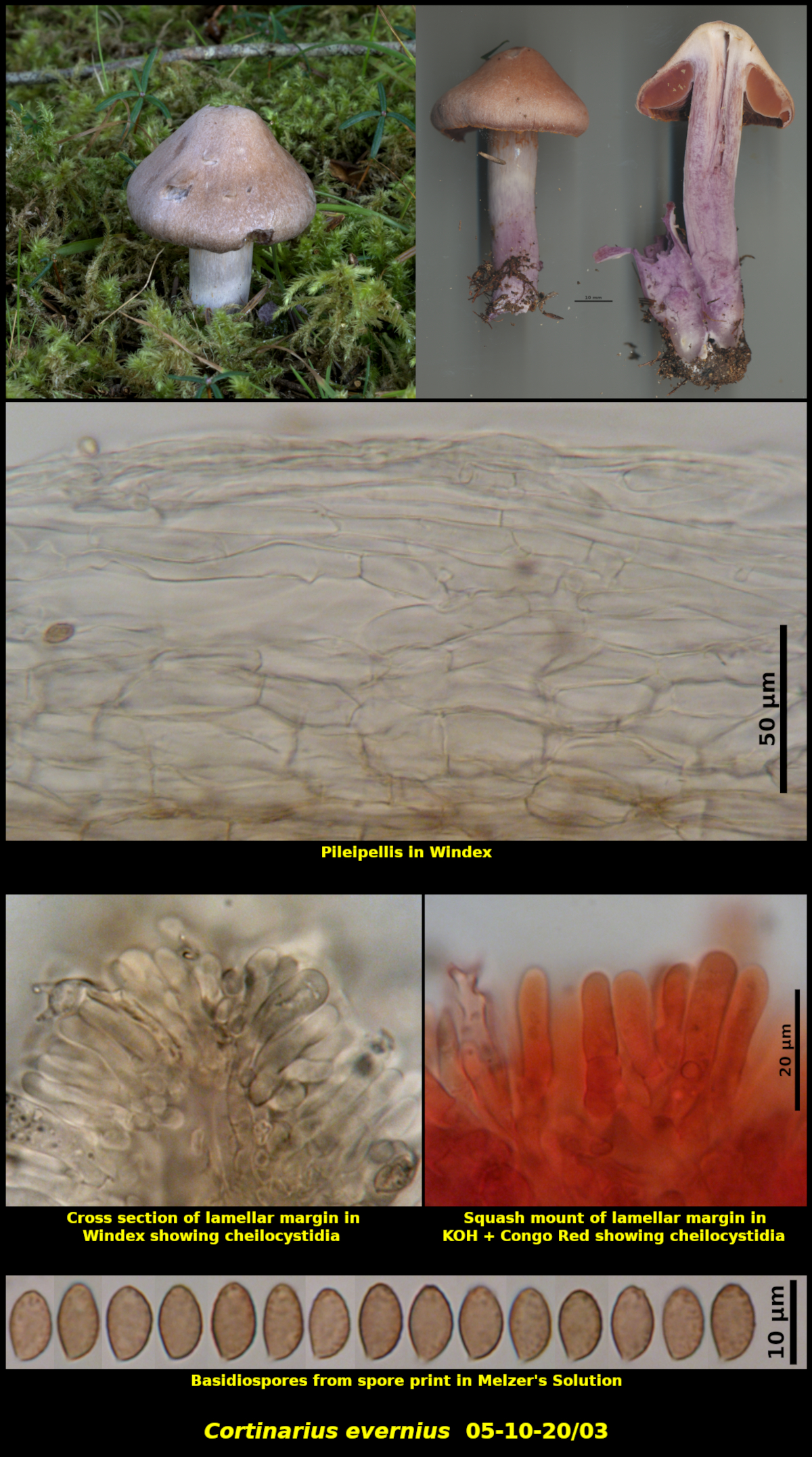Fleshy Fungi of New Brunswick >>
Cortinarius evernius
Cortinarius evernius (Fr.) Fr.


Two collections:
-
1. Gregarious (4) in a carpet of Pleurozium schreiberi and other mosses, associated with Abies balsamea, New River Beach Provincial Park, New Brunswick (23-09-18/03).
-
Pileus conic-turbinate at first, expanding to more broadly so at maturity, with a low but prominent broad umbo, dry, fibrillose at first with the universal veil, shiny, medium grey brown (HSV35:30:50-60), 18-23 mm in diameter. Stipe equal to very narrowly clavate, very finely streaked or banded with universal veil material, pale yellow (HSV55:05:100) in the upper 2/3, white to very pale violet (HSV250:03:100) below, dry, 55-93 X 5-8 mm. Lamellae chocolate brown (HSV35;80:40-50), white toward the edge but not really marginate, subclose, adnexed. Veil difficult to interpret. The universal veil on the pileus margin appears to be pale yellow and contrasts with the violet cortina. However, the bands on the stipe are yellow while the veil near the stipe base appears to be violet. Flesh in the pileus is a dilute brown below the pileipellis but is otherwise nearly white; in the stipe it is mostly white but has definite but very pale shades of violet near the middle, with a nondescript mushroom odour, slightly sweet but otherwise without a distinctive taste.
Basidiospores not forming a spore print, narrowly ovoid to ellipsoidal, with walls moderately roughened, 9.0-10.8 x 5.0-5.8 μm, Q = 1.63-1.95 (average[38]: 9.9 x 5.5 μm, Q = 1.81). Cheilocystidia forming a sterile margin, clavate, clamped at the basal septum. Pileipellis a dense cutis 23-39 µm thick, of narrow hyphae 1.4-2.5 µm in diameter. Lamellar trama parallel, light brown, obscurely encrusted with fine granules.
-
-
Pileus conic-turbinate at first, not seen when fully expanded, with a large rounded umbo, glabrous, light orange brown (HSV30:20-30:90) but probably hygrophanous and faded, slightly paler at the margin, dry, 43 mm in diameter. Stipe equal, dry, pale violet (HSV250:30-40:90), with universal veil present as a white annular band and irregular streaks below the annular zone, 75 X 13 mm. Lamellae dark brown (HSV20:70-80:30), subclose, adnexed, white at the margin. Cortina not seen, probably white. Flesh faded in the pileus but possibly concolorous with the surface tissues, pale violet (HSV250:30-40:90) in the stipe, lacking a distinctive odour and taste.
Basidiospores bright orange brown (HSV25:70:80-90) in spore print, ovoid to narrowly ellipsoidal, coarsely roughened, weakly dextrinoid, 8.1-9.5 x 4.7-5.7 μm, Q = 1.53-1.93 (average[60]: 8.8 x 5.2 μm, Q = 1.72). Cheilocystidia forming a partly sterile margin, barely distinguishable from immature basidia, narrowly clavate to almost cylindrical, with a basal clamp connection. Basidia clavate-4-spored, with a basal clamp connection. Lamellar trama parallel, brown, with clamp connections at the septa, only rarely encrusted. Pileipellis a cutis of hyaline hyphae over a subpellis of broader brown hyphae, with cells of subpellis rather short and almost brick-like. Clamp connections present on most septa.
2. Clustered (2, but one destroyed by rodents) among gametophytes of Rhytidiodelphus sp. in lawn, associated with Abies balsamea, Little Lepreau, New Brunswick (05-10-20/03).
This is a common species, often growing in dense clusters in coniferous forests along the Bay of Fundy. It is recognized by its often deep purple colours and well-developed universal veil. The yellow colours along the stipe in Collection 23-09-18/03 are not always present in more mature basidiomata. However, this particular collection has been sequenced (ITS) and is a good match for C. evernius. Cortinarius evernius is usually distinguished from similar species by the violet colour in the flesh of the stipe, which may extend to the base as in Collection 05-10-20/03. Most other similar species have the violet colours only at the apex.
Photographs: D. Malloch (23-09-18/03, 05-10-20/03).